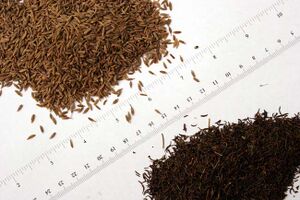Cumin

Plant name: Cuminum cyminum
Indian name: Jeera
Cumin can be used to season many dishes, as it draws out their natural sweetnesses. It is traditionally added to curries, enchiladas, tacos, and other Middle-eastern, Indian, Cuban and Mexican style foods. It can also be added to salsa to give it extra flavour. Cumin has also been used on meat in addition to other common seasonings. The spice is a familiar taste in Tex-Mex dishes and is extensively used in the cuisines of the Indian subcontinent. Cumin was also used heavily in ancient Roman cuisine.
Cultivation of cumin requires a long, hot summer of 3-4 months, with daytime temperatures around 30°C (86°F); it is drought tolerant, and is mostly grown in Mediterranean climates. It is grown from seed sown in spring, and needs a fertile, well drained soil.
Black cumin is a smaller seed than the white with a distinctive flavour. If you cannot get black cumin, use white.
In Islam, black cumin is regarded as one of the greatest forms of healing medicine available. Prophet Muhammad once stated that the black seed can heal every disease—except death—as recounted in the following hadith:
“ Narrated Khalid bin Sa'd:We went out and Ghalib bin Abjar was accompanying us. He fell ill on the way and when we arrived at Medina he was still sick. Ibn Abi 'Atiq came to visit him and said to us, "Treat him with black cumin. Take five or seven seeds and crush them (mix the powder with oil) and drop the resulting mixture into both nostrils, for 'Aisha has narrated to me that she heard the Prophet saying, 'This black cumin is healing for all diseases except As-Sam.' 'Aisha said, 'What is As-Sam?' He said, 'Death.' " (Bukhari)
Grind cumin seeds with a coffee grinder when you need them.
Great with:
See also
Find recipes that contain 'Cumin'
#cumin #cheese #spices #nigella #coffeegrinder #potatoes #onions #breads #lamb #aubergines #beansandpulses